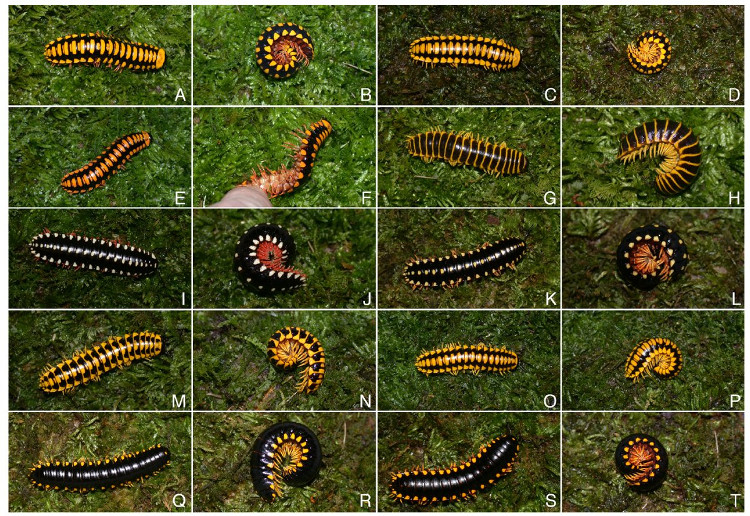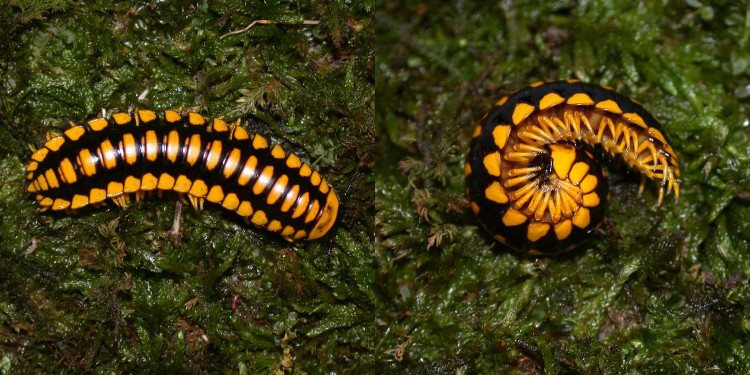This beautiful and tiny creature can take down 18 adult birds in a flash
Research shows that this rolling species can secrete an extremely toxic amount of cyanide - enough to knock down 18 adult birds.
Recently, scientists have discovered an extremely colorful rolling species. But it looks so beautiful, but in fact, this is a warning about its danger to the enemy.

Apheloria Polychroma slideshow.
This multi-legged creature, whose scientific name is Apheloria Polychroma , was found in the southwestern part of Virginia's Cumberland forest. Its colorful shell is covered with a layer of cyanide - as a protective film that stops the attack of predatory birds.
This is a fairly common defense mechanism of some arthropods. When attacked by the enemy, they secrete a mixture of hydrogen cyanide and benzoyl cyanide to protect themselves.

This is a fairly common defense mechanism of some arthropods.
In addition, they release a range of other toxins such as mandelonitrile benzoate and benzaldehyde - both of which are used as antibiotics and defenses.
So how does this rolling species use their "chemical weapons" ?
Some species release passive venom from the toxic glands, others roll their bodies to secrete venom, the rest actively launch venom when meeting an enemy.
The special thing here is, their bodies are equipped with immunity to cyanide toxicity. When there is a threat, they will secrete Cyanohydrin , decompose into hydrogen cyanide and release them immediately.

Its colorful shell is covered with a layer of cyanide.
According to researchers, this Apheloria specimen can produce enough hydrogen cyanide to knock down 18 adult birds.
The team also discovered several other rolling species that are gradually mimicking the ability of A. polychroma to camouflage - although this reproduction does not bring much benefit to them.
Camouflage is only effective at first, then when the predators are experienced, they can remember and stay away from the trap.
Paul Marek of Virginia Tech University said: "We need to document the description of this species, so that we can know the role in the ecosystem, as well as understand the factors affecting habitat. of them".
- The history of Flash - from dynamite to light-emitting diodes
- How do birds learn to sing?
- Baby birds also babble before singing
- Beautiful photo: The war of gulls
- Extract images in Flash file
- Lack of food makes young birds killed
- The most brilliant colorful birds in the world
- Aero Swf Max Flash Player An indispensable tool for flash
- 10 species of birds have beautiful long tail feathers
- What are flash floods? Where do flash floods occur, when?
- Beautiful 'transformation' creature like sapphire stone
- Instructions on how to get rid of safe flash floods
 Animal 'suffering' after hibernation
Animal 'suffering' after hibernation Why do goats climb well?
Why do goats climb well? Scientists were surprised to see chimpanzees eating turtles
Scientists were surprised to see chimpanzees eating turtles Giant catfish died deadly due to drought in Thailand
Giant catfish died deadly due to drought in Thailand What is sodium cyanide?
What is sodium cyanide?  What is potassium cyanide?
What is potassium cyanide?  The world's fastest deadly venom animal
The world's fastest deadly venom animal  7 horrible truths about cyanide - poison that is covering Tianjin
7 horrible truths about cyanide - poison that is covering Tianjin  How dangerous is the poison in the explosion in Tianjin?
How dangerous is the poison in the explosion in Tianjin?  Detecting cell membrane material on Titan moon
Detecting cell membrane material on Titan moon 